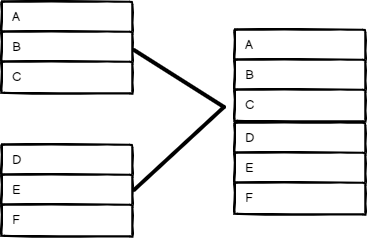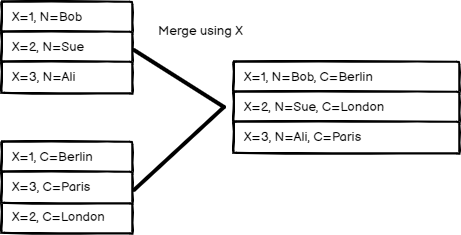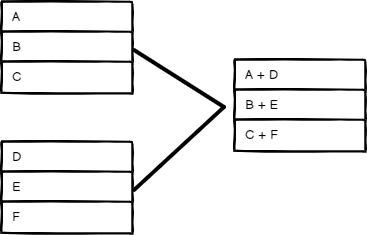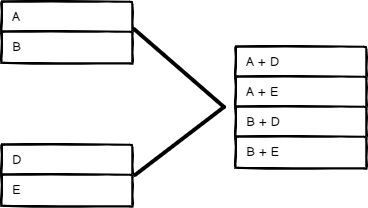Merge
Use the Merge node to combine data from multiple streams, once data of all streams is available.
Node parameters
You can specify how the Merge node should combine data from different data streams by choosing a Mode:
Append
Keep data from all inputs. Choose a Number of Inputs to output items of each input, one after another. The node waits for the execution of all connected inputs.

Combine
Combine data from two inputs. Select an option in Combine By to determine how you want to merge the input data.
Matching Fields
Compare items by field values. Enter the fields you want to compare in Fields to Match.
DeepOpinion's default behavior is to keep matching items. You can change this using the Output Type setting:
- Keep Matches: Merge items that match. This is like an inner join.
- Keep Non-Matches: Merge items that don't match.
- Keep Everything: Merge items together that do match and include items that don't match. This is like an outer join.
- Enrich Input 1: Keep all data from Input 1, and add matching data from Input 2. This is like a left join.
- Enrich Input 2: Keep all data from Input 2, and add matching data from Input 1. This is like a right join.

Position
Combine items based on their order. The item at index 0 in Input 1 merges with the item at index 0 in Input 2, and so on.

All Possible Combinations
Output all possible item combinations, while merging fields with the same name.

Combine mode options
When merging data by Mode > Combine, you can set these Options:
- Clash Handling: Choose how to merge when data streams clash, or when there are sub-fields. Refer to Clash handling for details.
- Fuzzy Compare: Whether to tolerate type differences when comparing fields (enabled), or not (disabled, default). For example, when you enable this, DeepOpinion treats
"3"and3as the same. - Disable Dot Notation: This prevents accessing child fields using
parent.childin the field name. - Multiple Matches: Choose how DeepOpinion handles multiple matches when comparing data streams.
- Include All Matches: Output multiple items if there are multiple matches, one for each match.
- Include First Match Only: Keep the first item per match and discard the remaining multiple matches.
- Include Any Unpaired Items: Choose whether to keep or discard unpaired items when merging by position. The default behavior is to leave out the items without a match.
Clash Handling
If multiple items at an index have a field with the same name, this is a clash. For example, if all items in both Input 1 and Input 2 have a field named language, these fields clash. By default, DeepOpinion prioritizes Input 2, meaning if language has a value in Input 2, DeepOpinion uses that value when merging the items.
You can change this behavior by selecting Options > Clash Handling:
- When Field Values Clash: Choose which input to prioritize, or choose Always Add Input Number to Field Names to keep all fields and values, with the input number appended to the field name to show which input it came from.
- Merging Nested Fields
- Deep Merge: Merge properties at all levels of the items, including nested objects. This is useful when dealing with complex, nested data structures where you need to ensure the merging of all levels of nested properties.
- Shallow Merge: Merge properties at the top level of the items only, without merging nested objects. This is useful when you have flat data structures or when you only need to merge top-level properties without worrying about nested properties.
SQL Query
Write a custom SQL Query to merge the data.
Example:
SELECT * FROM input1 LEFT JOIN input2 ON input1.name = input2.id
Data from previous nodes are available as tables and you can use them in the SQL query as input1, input2, input3, and so on, based on their order. Refer to AlaSQL GitHub page for a full list of supported SQL statements.
Choose Branch
Choose which input to keep. This option always waits until the data from both inputs is available. You can choose to Output:
- The Input 1 Data
- The Input 2 Data
- A Single, Empty Item
The node outputs the data from the chosen input, without changing it.
Merging data streams with uneven numbers of items
The items passed into Input 1 of the Merge node will take precedence. For example, if the Merge node receives five items in Input 1 and 10 items in Input 2, it only processes five items. The remaining five items from Input 2 aren't processed.
Branch execution with If and Merge nodes
If you add a Merge node to a workflow containing an If node, it can result in both output data streams of the If node executing.
One data stream triggers the Merge node, which then goes and executes the other data stream.
For example, in the screenshot below there's a workflow containing an Edit Fields node, If node, and Merge node. The standard If node behavior is to execute one data stream (in the screenshot, this is the true output). However, due to the Merge node, both data streams execute, despite the If node not sending any data down the false data stream.